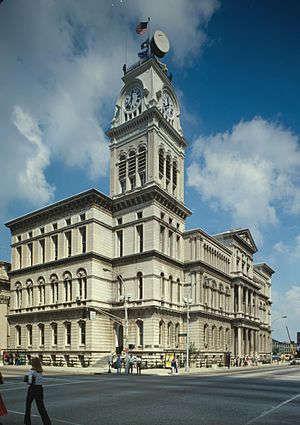Government of Louisville, Kentucky facts for kids

The government of Louisville, Kentucky runs Louisville Metro. This is a special type of government where the city of Louisville and the surrounding Jefferson County joined together. This big change happened on January 6, 2003.
Louisville Metro has a mayor–council government. This means there's a leader called the Mayor of Louisville Metro (or "Metro Mayor"). There's also a group of lawmakers called the Louisville Metro Council (or "Metro Council"). They work together to manage most of the jobs that the old city and county governments used to do separately. Some jobs, like the County Clerk and Sheriff, still operate on their own. Louisville Metro was the second government in Kentucky to combine this way. The first was Lexington and Fayette County in 1974.
The current Metro Mayor is Greg Fischer (Democrat). He started his job on January 3, 2011. The Metro Council has twenty-six members. Each member represents a different area (district) of the county. Council members serve for four years. Every two years, half of the seats (thirteen) are up for reelection. The council chooses one of its members to be the Council President each year. Currently, the Democrats have more members on the council than the Republicans.
Before the merger, Louisville was known as a "first-class" city in Kentucky. This meant it had special rules for things like public safety and alcohol. As of 2014, it's the only city in the state with this special title.
The old official seal of Louisville showed its history. It had a fleur-de-lis, which is a French symbol. This represented the help France gave during the American Revolutionary War. It also had thirteen stars for the original British colonies. The new Seal of Louisville Metro still has the fleur-de-lis. But now it has two stars, one for the city and one for the county.
Most of Louisville Metro is part of Kentucky's 3rd congressional district. This district is represented by Rep. John Yarmuth (Democrat). A small part of the far southeast is in the 4th congressional district. This area is represented by Thomas Massie (Republican). Most voters in the 3rd congressional district are Democrats. Louisville has not elected a Republican mayor since 1965.
History of Louisville's Government
Early Legislative Bodies
The idea of local government in Louisville started very early. In 1779, the first settlers chose five men as "trustees." In 1780, Virginia, which Louisville was part of, officially created the town. The Virginia legislature then appointed nine trustees to run the local government. When Kentucky became a state in 1792, the Kentucky legislature took over appointing these trustees.
At first, trustees didn't even have to live in Louisville. But a law change in 1795 made them live there. In 1797, citizens finally got the right to elect their own trustees. This was a big step towards "home rule." However, most important decisions were still made by the state. The trustees mostly managed things rather than making new laws.
When Louisville officially became Kentucky's first city in 1828, it gained more control over its own affairs. A new group called the "Common Council" was formed. It had ten members and was led by a mayor. In 1851, the city got a new charter. This kept the Common Council as a "lower house." It also added the Board of Aldermen as an "upper house." This meant the city had two groups that made laws. In 1929, the Common Council was removed. The Board of Aldermen became the main lawmaking group until the city and county merged.
The 26-member Louisville Metro Council was officially created in January 2003. This happened when the city of Louisville and Jefferson County governments joined. The Metro Council took the place of both the city's Board of Aldermen and the county's Fiscal Court.
The Role of the Mayor
The first election for mayor happened in March 1828. At that time, only free white men who had lived in the city for at least six months could vote. Mayors were not directly chosen by the voters at first. The two people with the most votes were sent to the Governor. The Governor then picked the mayor from those two, with approval from the state senate.
The early mayor didn't have a lot of power. They mostly acted like a Justice of the Peace, helping with legal matters. They served for only one year and couldn't vote on the City Council unless there was a tie.
In 1838, the city charter changed. This allowed people to directly elect the mayor. The mayor's term was also made longer, to three years. However, mayors couldn't run for reelection right away. From 1851 to 1870, the term was two years, then it went back to three. In 1894, the Kentucky Legislature set the mayor's term at four years.
In the early 1900s, there were problems with corruption in politics. Because of this, mayors from both political parties were sometimes removed from office by the courts. In 1929, all lawmaking power was given to the Board of Aldermen. Over time, the African American community became unhappy with how slowly civil rights issues were being addressed. This led to a shift in voting patterns. More people started voting for progressive Republicans in mayoral elections, especially in 1961. Louisville never stopped African Americans from voting, even though it was seen as a "southern" city. In 1986, a rule was set that mayors could only serve three terms.
On January 6, 2003, the city of Louisville and Jefferson County governments combined. This created the new Metro Government and the new job of Mayor of Louisville Metro.

